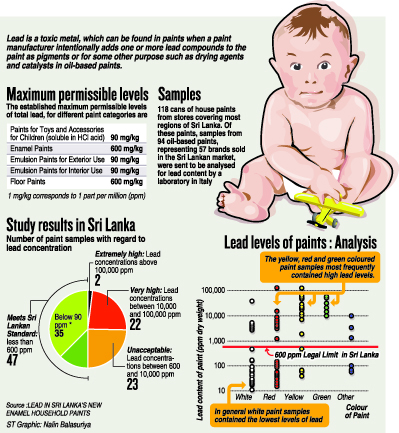News
Lead mixed paint should be taboo for sprucing up schools
The new academic year has started and with it schools big and small across the country go on a spree of painting not only the classroom walls but also the desks and chairs.
Herein may lie a hidden danger, warns a top doctor, reiterating that schools should ensure that the paint being used in classrooms and on desks and chairs should be lead-free.

Dr. Waruna Gunathilake
For, if enamel paint is used and that contains a high-level of lead, the impact on children, especially the younger ones would be disastrous, underscores Dr. Waruna Gunathilake, Head of the Toxicology & National Poisons Information Centre.
He reiterates that evidence of reduced intelligence caused by childhood exposure to lead has resulted in the World Health Organization (WHO) categorising lead-caused mental retardation as a recognised disease. This is why the WHO has placed it as one of the top 10 diseases whose health burden among children is due to modifiable environmental factors.
Lead exposure usually occurs after the paint has dried on the walls or the desks and chairs, he says, pointing out that when painted surfaces age, they may chip with time.
“It is then that any lead that is in the paint mixes with the indoor and outdoor dust and soil in and around the painted building.
Children, particularly small ones, up to about six years of age, tend to put their fingers in their mouth or even lick surfaces sometimes and if the environment is lead-contaminated will ingest this heavy metal,” says Dr. Gunathilake who is also Director of the Information Centre based at the National Hospital of Sri Lanka.
 A typical one to six-year-old child ingests around 100 milligrams of dust and soil each day, the Sunday Times learns, and this is the group at the highest risk of being harmed by exposure to lead.
A typical one to six-year-old child ingests around 100 milligrams of dust and soil each day, the Sunday Times learns, and this is the group at the highest risk of being harmed by exposure to lead.
Paint chips are more harmful since their lead content may be higher than in dust and soil, according to him, although children are usually not exposed to lead from paint while the paint is still in the can or even when the paint is freshly applied to a previously unpainted or uncoated surface.
His warnings are not without foundation, as he cites the report ‘Lead in Paint – Sri Lanka’ released last year which is an eye-opener. (See graphic)
The study had been carried out by the Centre for Environmental Justice for the ‘Asia Lead Paint Elimination Project’ of the international organization IPEN which is promoting safe chemical policies and practices that protect human health and the environment. The project funded by the European Union is being carried out in seven Asian countries including Sri Lanka.
Reiterating that exposure to lead is “much more harmful to children” than adults and the effects are generally irreversible, Dr. Gunathilake gives the reasons why schools should be extra-careful about the paints they use.
Echoing well known dangers, he stresses that the younger the child, the more harmful the lead can be, with the foetus being the most vulnerable. “If an expectant mother has lead accumulation in her body, that can get transferred to the baby she is carrying in her womb.”
The severe adverse impacts on young children, according to this Toxicologist, include:
-Brain damage due to chronic low-level exposure to lead during the early years as a child’s brain undergoes very rapid growth, development and differentiation around that time, with lead definitely interfering with this process.
- Lead exposure in early life could re-program the child’s genes, paving the way for an altered gene expression linked to increased disease later in life.
- Gastrointestinal absorption of lead is enhanced in childhood, while in children who have nutritional deficiencies such as iron deficiencies there is an increased rate of absorption if this toxic metal gets ingested.
Detailing the health effects, Dr. Gunathilake says that cognitive development is affected because lead interferes with neuro-transmitter synthesis. Lead also affects mitochondrial (the energy storehouse at cell-level) functioning.
| Warning to pre-schools, homes and hospitals
A similar caution goes to pre-schools, homes and hospitals. Be wary of the paint you use, urges Dr. Gunathilake, especially on the tiny desks, chairs and brightly-painted blocks in pre-schools; the cradles, cots and toys in homes and in children’s wards. |

